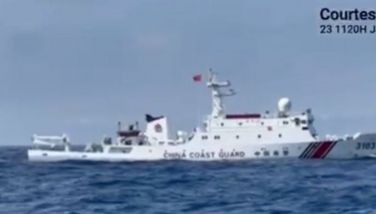Provocation

A Visiting Forces Agreement or VFA with Japan, according to President Marcos, should not provoke tension in the South China Sea.
But an agreement is not provocative. A VFA fosters a security partnership that is meant to deter armed conflict and promote peace.
Only actions are provocative, whether covered by a security agreement or not. Pointing a blinding military-grade laser at the Philippine Coast Guard (PCG) ship Malapascua, which was on a resupply mission to our troops in Ayungin Shoal, as the Chinese coast guard did on Feb. 6, is a provocative act.
Even more provocative is a Chinese military vessel pointing a naval gun at the PCG ship Teresa Magbanua near Ayungin in August last year (but reported only now by the Armed Forces of the Philippines).
Ayungin (Second Thomas) Shoal is one of several features in the South China Sea over which the Philippines was awarded sovereign rights by the Permanent Court of Arbitration in The Hague in 2016. The others are Panganiban (Mischief) Reef and Recto (Reed) Bank.
The presence of Chinese military vessels in those areas is a provocation in itself. Yesterday, the PCG said China has been deploying about 150 militia ships in “swarm” formation in the West Philippine Sea.
Beijing, reacting to the laser-pointing incident, said the Philippines should respect and not intrude into its territory. Shouldn’t the admonition be the other way around?
We have a six-year-old ruling by an international court on our side. What is the basis for Beijing’s nine-dash-line claim, already wholly invalidated by the arbitral ruling?
The laser-in-your-face incident occurred just over a month after Marcos met with Chinese President Xi Jinping in Beijing. Does friendship mean bowing to China’s maritime territorial claims?
Yesterday, BBM himself summoned Chinese Ambassador Huang Xilian to Malacañang to convey the Philippines’ displeasure.
* * *
Since Beijing is claiming as its own nearly the entire South China Sea almost right down to our shorelines, it will consider provocative any activity conducted by the AFP and PCG (a civilian agency) without Chinese permission in the SCS.
Beijing has already openly protested against the expansion of the Enhanced Defense Cooperation Agreement between the Philippines and the United States, which will give US military forces access to four additional AFP facilities.
The Philippines and US are set to conduct joint patrols in the West Philippine Sea under the Mutual Defense Treaty (MDT). Beijing will surely consider this provocative.
A VFA, which we also have with Australia, does not necessarily involve joint maritime patrols. It covers joint military drills, training and information exchanges, capacity building, environmental protection operations as well as disaster rescue and relief involving military troops and assets.
In case a VFA is forged with Japan, Beijing will likely find it provocative anyway, with or without joint patrols or military drills by the two countries either in the West Philippine Sea or around the Senkaku Islands – the subject of a territorial dispute between Japan and China.
We need closer defense ties with other countries especially as airspace becomes the next arena for geopolitical rivalries.
In just three days, US fighter jets have shot down three unidentified flying objects (giving a new dimension to the meaning of UFO) over Alaska, Canada and Lake Huron near the US-Canada border. (Some initial reports erroneously said the UFO shot down over Canada was the same one from Alaska.)
The three are in addition to the high-altitude balloon or surveillance HAB that the US shot down off the South Carolina coast on Feb. 4 after it hovered near a military base in Montana. The US is now scouring its skies for more radar-evading, slow-moving HABs.
China has acknowledged ownership only of the HAB, and denied its use for spying. As for the three UFOs that were shot down over the weekend, Beijing’s reaction was to point out that the US deployed over 10 spy balloons over Chinese airspace since January 2022.
* * *
Retired Supreme Court Senior Associate Justice Antonio Carpio said the laser incident could be considered an armed attack under which the Philippines could invoke the MDT with the US.
Prof. Jay Batongbacal, director of the University of the Philippines Institute for Maritime Affairs and Law of the Sea, told “The Chiefs” on Cignal TV’s One News last Monday that international rules governing the use of military-grade lasers and what constitutes sovereign airspace are still gray areas waiting to be defined.
But even if the international community agrees on such rules and definition, would China abide by them? It is a signatory to the United Nations Convention on the Law of Sea, which was used as a basis for the arbitral court ruling. Yet toilet paper has more value than that ruling, as far as Beijing is concerned.
Defense Secretary Carlito Galvez reportedly described the laser incident as “offensive” and “unsafe.”
On Monday, the Chinese foreign ministry pinned the blame for the incident on the Philippines, saying the PCG vessel “intruded into the waters off the Ren’ai Reef without Chinese permission.”
In this incident, who’s provoking whom?
China is behaving like the owner of nearly the entire South China Sea. Any affected country that does not resent that greedy claim has no self-respect.
What can countries with weaker armed forces do? Turn to those with strong armies for alliances anchored on shared values and good neighborliness. This is what aiming a naval gun and a military-grade laser beam at a foreign vessel does.
Hawks say that incident involving the naval gun can be considered a provocative act of belligerence.
When provoked, the Philippines lacks the capability for direct armed confrontation. But it can be provoked into strengthening security alliances.
- Latest
- Trending





























